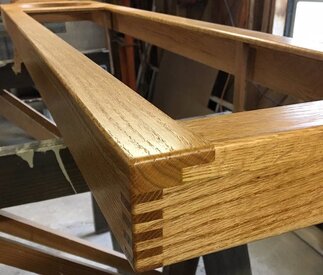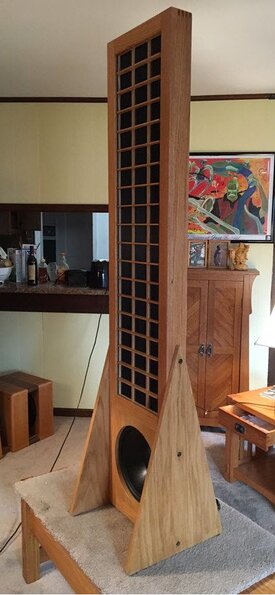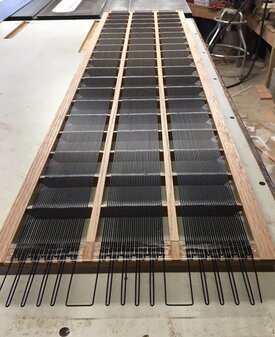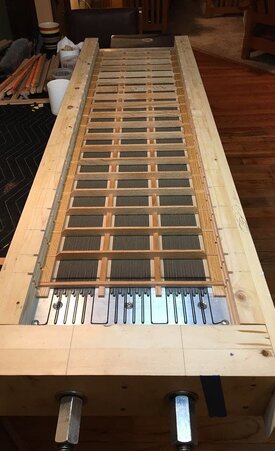Hi all,
Since October of last year I've been toiling away on my biggest-ever ESL speaker project, and I'm very happy to be nearing completion after 5 months of exhausting work.
Several of my Carver Audio friends have twisted my arm for years to build speakers for them, but until now I've declined because my designs are exhausting builds, especially for an old guy like me. My friends prefer my lightweight OB hybrid speaker because it's prettier and easier to transport than my other designs. I must have bumped my head somewhere because I finally agreed to do it.
I'm building four (4) pairs of the OB design which uses a 12" woofer mounted on a modified H-baffle. The frames are red oak and the stat panels use segmented wire stators which electrically bend the wave front from planar to cylindrical. Bending the wave front is accomplished using a stepped-frequency/phased-array of (15) wire groups which drive the diaphragm sequentially from the panel centerline outward.
The stator wires are 20 AWG, UL-1061 SRPVC-insulated, single-strand copper. The HV bias supplies are simple 3.2kV diode/capacitor cascades, and the step-up transformers are tandem pairs of 50VA 230V/2x6V toroids wired for 76:1 step-up ratio. The diaphragms are 6-micron Mylar C with a 2-micron Licron Crystal ESD coating giving E7-E9 Ohms resistance. The speakers are bi-amplified using a DSP crossover.
Below are a few build pics and three videos showing the stator/panel build process and a completed speaker.
Enjoy!
Wire stator build video:
https://youtu.be/814iWnmz6_4
Panel assembly video:
https://youtu.be/ECM3gfrJPxQ
Completed speaker video:
https://youtu.be/Q_4sddiBEoU
Since October of last year I've been toiling away on my biggest-ever ESL speaker project, and I'm very happy to be nearing completion after 5 months of exhausting work.
Several of my Carver Audio friends have twisted my arm for years to build speakers for them, but until now I've declined because my designs are exhausting builds, especially for an old guy like me. My friends prefer my lightweight OB hybrid speaker because it's prettier and easier to transport than my other designs. I must have bumped my head somewhere because I finally agreed to do it.
I'm building four (4) pairs of the OB design which uses a 12" woofer mounted on a modified H-baffle. The frames are red oak and the stat panels use segmented wire stators which electrically bend the wave front from planar to cylindrical. Bending the wave front is accomplished using a stepped-frequency/phased-array of (15) wire groups which drive the diaphragm sequentially from the panel centerline outward.
The stator wires are 20 AWG, UL-1061 SRPVC-insulated, single-strand copper. The HV bias supplies are simple 3.2kV diode/capacitor cascades, and the step-up transformers are tandem pairs of 50VA 230V/2x6V toroids wired for 76:1 step-up ratio. The diaphragms are 6-micron Mylar C with a 2-micron Licron Crystal ESD coating giving E7-E9 Ohms resistance. The speakers are bi-amplified using a DSP crossover.
Below are a few build pics and three videos showing the stator/panel build process and a completed speaker.
Enjoy!
Wire stator build video:
https://youtu.be/814iWnmz6_4
Panel assembly video:
https://youtu.be/ECM3gfrJPxQ
Completed speaker video:
https://youtu.be/Q_4sddiBEoU













